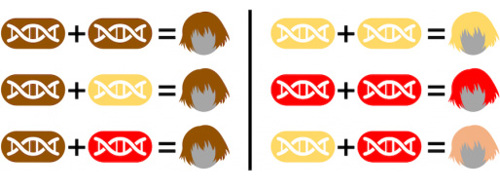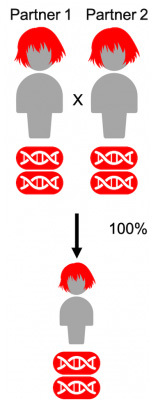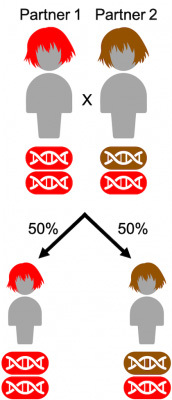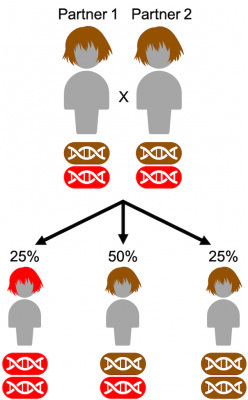
What are my chances of having a red haired child?

- Related Topics:
- Common questions,
- Red hair,
- Hair color,
- Pigmentation traits,
- Dominant and recessive,
- Carrier
Many curious parents from around the world ask:
“What are my chances of having a red haired child?”
Worldwide, red hair is quite rare. And a lot of people wonder about the chances that their children will be in that group!
We do know quite a lot about how red hair is inherited – but some of the details still need to be figured out! We will start with a mostly-true answer first, and then we can get into more complex details.
Redhead basics
As you might have heard, you inherit genetic information from each of your parents. And then you will pass your genetic information to your children.
Your genetic information, or DNA, is organized into small pieces called genes. Genes have the instructions to make you who you are, including your hair color! Genes come in different versions, called alleles.
So let’s imagine that there’s one gene that controls hair color. The different alleles of this gene could be “brown hair”, “blonde hair” and “red hair”. If you have the brown allele of the gene, you have brown hair. If you have the blond allele, you have blonde hair. And if you have the red allele, you have red hair.
But it’s not so simple - you don’t only have ONE allele for each gene. You actually have two: one from your mom and one from your dad. They could both be for the same hair color… or they might be for two different colors.
It may seem obvious that if you have two brown hair alleles you will have brown hair. But what if you have “brown DNA” plus “blonde DNA”? Or brown plus red, or blonde plus red?
It turns out that brown hair DNA is stronger than the other colors. You only need one brown allele to have brown hair. It is a dominant trait.
The DNA for blonde or red hair is not as strong as brown. In order to have blonde hair, both of your alleles need to be blonde. The same is true for red hair. These are recessive traits.
The DNA for blonde hair and red hair are about equally strong. People who have DNA for both often have strawberry blonde hair.
Putting it all together you get:
- Brown DNA + brown DNA = brown hair
- Brown DNA + red DNA = brown hair
- Brown DNA + blonde DNA = brown hair
- Blonde DNA + blonde DNA = blonde hair
- Red DNA + red DNA = red hair
- Red DNA + blonde DNA = strawberry blonde hair

So what does that all mean for your chances of having a red-headed child?
Since you need two pieces of “red hair” DNA to have red hair, your child will only have red hair if they receive “red hair” DNA from both parents.
Even if you don’t have red hair, you can still pass on a red hair allele to your child! Since red hair is recessive, you could carry instructions for making red hair hidden in your DNA. Someone like that is called a carrier for red hair.
Since carriers don’t actually have red hair, it’s hard to know if you are one. But if you know you have redheads in your family, it’s quite possible you have hidden redhead DNA!
Following this pattern of inheritance, you can have a redheaded child given 3 different scenarios:
1. Both you and your partner have red hair = 100% chance of having a redheaded child

2. One parent has red hair and the other one doesn’t, but secretly carries the red hair allele = 50% chance of having a redheaded child

3. You and your partner don’t have red hair, but you both carry the red hair allele = 25% chance of having a redheaded child

It’s complicated!
For the most part, the way hair colors are passed down matches my explanation above. However, the story isn’t quite so simple. As with pretty much everything in genetics, the “rules” are often broken!
It turns out there isn’t just one gene that controls hair color.
Your hair gets its color from a type of pigment, called melanin. You have two types of melanin in your hair: eumelanin and pheomelanin.
Eumelanin is a brown pigment. It colors hair and skin shades of brown and is responsible for skin tanning. On the other hand, pheomelanin has a reddish color and is present in the lips, nipples and genitals.
All humans have small amounts of pheomelanin in their hair. But if there’s a lot of eumelanin, the brown pigment drowns out any red color. However, if someone has very little to no eumelanin, their hair appears red. The lack of eumelanin also causes fair skin.
As you might have noticed, there are different shades of red hair. It all depends on the combination of eumelanin and pheomelanin that each redheaded person has!
And what controls how much of each type of melanin your body makes? Multiple different genes are in charge of working together to give you your specific hair and skin color.
In fact, skin and hair color depend on a bunch of different genes working together. There are dozens of genes that are known to affect hair color, and hundreds of genes for skin color. And we surely even have more to discover!
If that wasn’t enough, there are some external factors that can change the way genes work.
For example, hormones can cause blonde hair to get darker as children get older. Some other factors can lead the hair color to fade, including stress, sunlight, smoking, a poor diet…
All of that means that even if two people have the exact same combination of multiple genes … they might still have different color hair.
In conclusion…
Hair color genetics is surprisingly complicated! There are a lot of different genes that impact hair color, plus a lot of non-genetic factors. Scientists are still looking into the genetics of hair color, so I am sure we will have more definite answers in the near future!
Read More:
- MedlinePlus: Is hair color determined by genetics?
- Science Daily: Scientists discover 8 additional genes linked to red hair
- NYTimes: The pain of being a redhead
- Other Ask-a-Geneticist articles: We've actually gotten a lot of red hair questions over the years, which you can find here.

Author: Marina Sumarroca
When this answer was published in 2020, Marina was a student in the Stanford MS Program in Human Genetics and Genetic Counseling. She wrote this answer while participating in the Stanford at The Tech program.
 Skip Navigation
Skip Navigation
